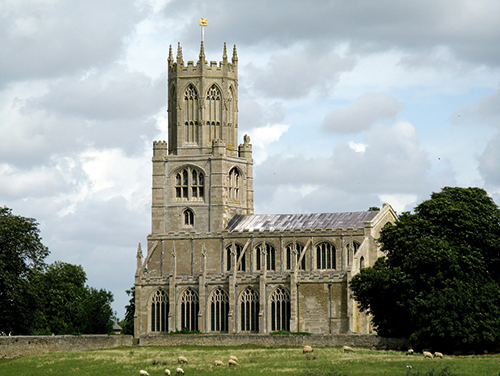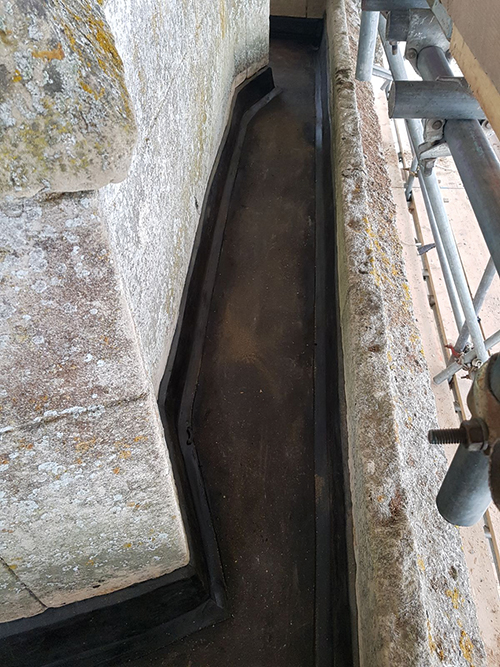Award-winning project proves the value of mastic asphalt
 Back in 2018 an impressive roof refurbishment project was completed at the Church of St Mary and All Saints in Fotheringhay, Peterborough – a magnificent 15th-century, Grade One-listed building.
Back in 2018 an impressive roof refurbishment project was completed at the Church of St Mary and All Saints in Fotheringhay, Peterborough – a magnificent 15th-century, Grade One-listed building.
The project was carried out during one of the coldest winters on record by contractors BCC Asphalt – who are members of the Mastic Asphalt Council (MAC) – and was completed in just 14 days. The project was named the winner of the Challenge Trophy Award in the MAC 2018 Awards, presented at the Royal Horseguards Hotel in London.
The Church of St Mary and All Saints has witnessed a number of significant historical events. They include the execution by beheading of Mary Queen of Scots at nearby Fotheringhay Castle in 1587.
The church roof had never been protected with a roofing system since the structure was built and due to restricted access the roof had never been maintained.
The natural stone and concrete substrate were allowing damp and water to penetrate into the building. Over the years moss had collected in the joints of the concrete on the roof, and the concrete itself was severely water-stained and absorbing water.
Urgent repairs were required to the roof to prevent further water infiltration and other remedial work was also carried out to the rest of the building, including repairs to the stonework of the church tower and the replacement of leadwork and timbers on the tower.
Funding for the project was raised by the Friends of Fotheringhay Church and benefitted from the patronage of HRH The Duke of Gloucester, as well as many other charitable donors – including a £700,000 donation from the HB Allen Trust, which funds the restoration of the fabric of churches.
The architect specified the use of mastic asphalt for the roof refurbishment because of the building’s listed status and the fact that mastic asphalt has an outstanding track record of use in heritage projects such as Westminster Cathedral, St Paul’s Cathedral, the Tower of London and Dover Castle.
Traditionally consisting of graded limestone aggregate bound together with bitumen, today’s mastic asphalt systems are manufactured using advanced polymer-modified formulations, to ensure all the performance characteristics of traditional asphalt systems, with the added benefits of increased flexibility, enhanced handling and sustainability. The incorporation of modern polymers into mastic asphalt systems has helped lead to its resurgence in the construction industry.
Three roofing contractors tendered for the work and BCC Asphalt were awarded the contract based on their competitive price, track record of successful mastic asphalt applications and the fact that they are members of the Mastic Asphalt Council.
The listed nature of the building led to significant challenges in terms of the mastic asphalt application, which was carried out at a problematic working height in very difficult weather conditions. The church is situated at the top of a hill and the applicators had to contend with extreme wind and very cold temperatures.
Four operatives from BCC Asphalt were involved in the roof refurbishment and the only access to the roof for the duration of the contract was via two material hoists set in two stages of the scaffolding. One operative was on the ground mixing the mastic asphalt and hoisting it up to the first 50ft gantry and then to the second access point, which was approximately 100ft up at the top of the church tower.
 Once repairs to the stonework were completed and the existing surface had been cleaned and primed, sheathing felt was installed before two coats of a specially-formulated mastic asphalt roofing system were applied. Advanced polymer technology was used to give the ideal combination of long-term durability, increased fatigue resistance, improved temperature stability and ease of installation. Mastic asphalt was applied at a thickness of 20mm in two coats to existing falls, including the church’s perimeter gutter. Two coats of mastic asphalt were also applied at 13mm to the skirting of the stonework, before being painted with solar reflective paint.The building was kept watertight as works progressed and different contours and curves of gutters were expertly matched using mastic asphalt. Due to the tight access to the asphalt gutters it was extremely challenging for the roofing contractor to lay the asphalt skirting and complete the detail work.
Once repairs to the stonework were completed and the existing surface had been cleaned and primed, sheathing felt was installed before two coats of a specially-formulated mastic asphalt roofing system were applied. Advanced polymer technology was used to give the ideal combination of long-term durability, increased fatigue resistance, improved temperature stability and ease of installation. Mastic asphalt was applied at a thickness of 20mm in two coats to existing falls, including the church’s perimeter gutter. Two coats of mastic asphalt were also applied at 13mm to the skirting of the stonework, before being painted with solar reflective paint.The building was kept watertight as works progressed and different contours and curves of gutters were expertly matched using mastic asphalt. Due to the tight access to the asphalt gutters it was extremely challenging for the roofing contractor to lay the asphalt skirting and complete the detail work.
BCC Asphalt’s managing director Wayne Cooper began his career as a mastic asphalt apprentice, undertaking a four-year apprenticeship at Hackney College. He established BCC Asphalt with a former partner in 1992 and has been a member of the Mastic Asphalt Council for around 10 years.
Commenting on the project at Fotheringhay, he said: “The Church of St Mary and All Saints project was one of the most challenging I have ever been involved in over the years. The application was undertaken in February during one of the coldest winters in many years and the wind circled around the church from morning till night. It was an awkward application with severely restricted access, and not much room for us to manoeuvre, but mastic asphalt was absolutely ideal for this job due to the Grade One-listing of the building and the detail work we could carry out using mastic asphalt.
“We are getting more work for heritage applications where mastic asphalt has been specified and are being contacted by the likes of English Heritage. This job is the third mastic asphalt contract we have completed on a Grade One-listed building in the past two years and that looks set to continue as more people involved in heritage applications realise the benefits of mastic asphalt, and its proven ability to offer a design life well in excess of 100 years. We need more mastic asphalt applicators in the industry to help continue its legacy.”
For further information visit www.bccasphalt.co.uk















